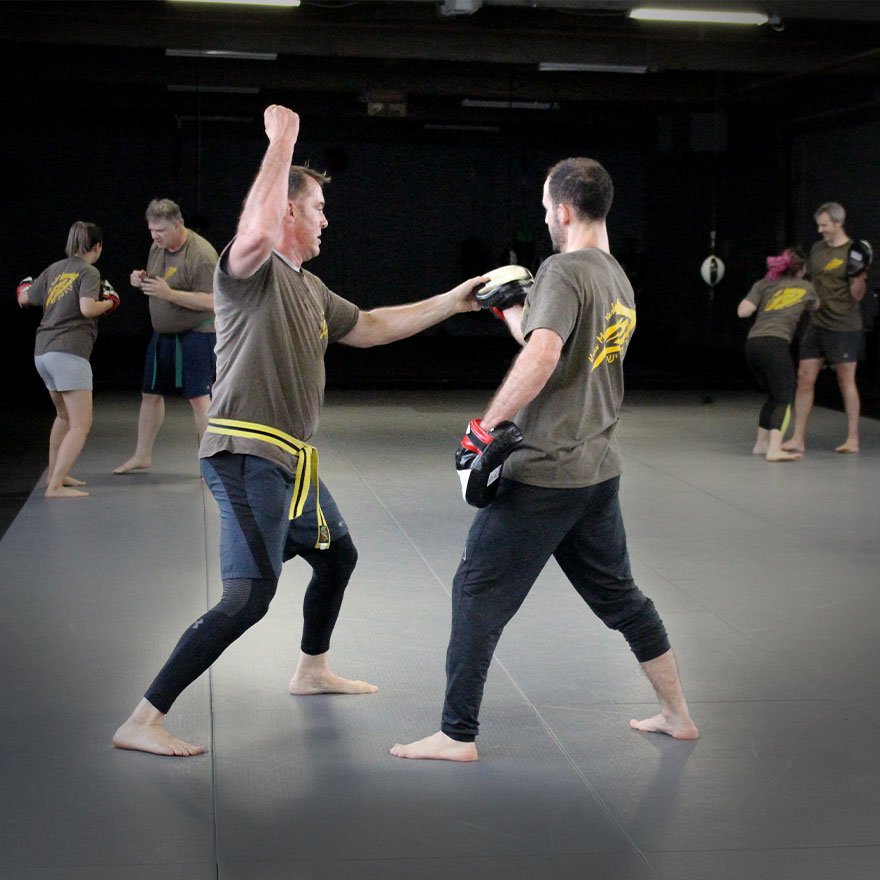The Importance of Striking In Mixed Martial Arts

Effective Striking For Fighting
Standup striking, which includes punching and kicking techniques, is an essential component of self-defense and martial arts training, and needs to be mixed with grappling and groundwork, along with transitioning between these phases in order to provide a comprehensive approach to fighting. Good striking enables a fighter to respond effectively to threats in scenarios where distance is able to be maintained etc., making it a valuable skill for avoiding harm and escaping dangerous situations (In scenarios where distance isn’t able to be maintained grappling skills are required). Striking is not only about delivering forceful attacks but also about managing distance, timing, and precision to neutralize another fighter efficiently. Much of our striking training involves the management of range and distance. Key skills which also allow blocks/blocking to be effective. When range is not maintained a fighter may be forced to “cover” in order to protect themselves. Whilst covering can be effective, along with effective head and body movement when working at close range, it can also make a fighter “blind” to other attacks as covering can restrict sight-lines.
Punching is one of the most basic and accessible striking techniques for fighting. The ability to deliver a well-placed punch can quickly stop an aggressor or create an opportunity to disengage/escape – by delivering pain and/or concussive force. Key punches such as the jab, cross, hook, and uppercut are foundational in boxing and other martial arts. The jab, a quick and straight punch with the lead hand, is particularly effective in fighting because it allows the defender to maintain distance whilst testing/discovering an attacker’s intentions; it is also a useful tool in preventing another fighter from closing and taking away distance/range. The cross, a more powerful straight punch delivered with the rear hand, can potentially serve as a knockout strike if timed and placed correctly (whilst in sporting settings delivering knockout strikes is relatively common in real-life settings it is quite rare). Hook punches and uppercuts are close-range techniques that can be devastating in scenarios where an aggressor is extremely close and within arm’s reach (the boxer Mike Tyson showed the devastating power of these punches. Each of these punches relies on proper body mechanics, including hip rotation and balance, to maximize force whilst minimizing the risk of injury to the defender. The correct and proper execution of such techniques/strikes is one of the things that is practiced at our gym just north of Boston.
Kicking allows a defender to utilize their legs to maintain or increase distance from an attacker. Kicks can target various parts of the body, such as the legs, torso, or head, depending on the situation and the defender’s level of training. Low kicks, such as shin or knee strikes to the attacker’s thighs or knees, are particularly effective because they are hard to see coming and can incapacitate an aggressor by damaging their ability to stand or move effectively (Keith Jardine in his 2007 fight against Chuck Liddell – who was seen as unstoppable at the time – destroyed and eventually incapacitated Liddell through the use of low kicks to the legs). In recent years calf kicks have been shown to be very effective in MMA (Mixed Martial Arts). Mid-level kicks to the torso, such as front kicks, can push an attacker/fighter away and create space to disengage and reset. High kicks to the head, whilst powerful, are less practical in self-defense settings due to their slower execution and the risk of losing balance, along with the restrictions that clothing can cause; problems and issues that are less common in the cage and ring etc. This doesn’t mean that they don’t have their place but rather that their use should be restricted to specific types of situations.
One of the most critical aspects of standup striking for fighting is precision. Unlike competitive sports, where multiple strikes may be thrown in combinations to overwhelm an opponent, self-defense emphasizes efficiency, meaning that a single well-placed strike can end a confrontation more effectively than a flurry of poorly executed attacks. Strikes targeting vital areas, such as the jaw, nose, throat, solar plexus, or knees, can incapacitate an aggressor quickly. Proper targeting reduces the amount of force required to neutralize a threat, making effective fighting techniques and tactics accessible even to individuals without significant physical strength. This doesn’t mean that such strikes are easy to land but rather because targets aren’t restricted by rules, the opportunities to strike such areas and end the fight quickly are often available.
Timing and distancing are equally important when fighting. Knowing when and how to strike can mean the difference between neutralizing a threat and escalating a dangerous situation e.g., a strike which hurts but angers can be dangerous depending on the person you are dealing with, which is why learning how to strike vulnerable targets with power and accuracy – to end the fight quickly - is an important skill to develop. The ability to judge the distance between oneself and an attacker allows the defender to execute strikes without exposing vulnerabilities. For example, a well-timed jab can interrupt an attacking fighter’s approach, whilst a defensive sidekick can prevent them from closing the gap. Maintaining proper footwork and balance ensures that the defender remains mobile and ready to adapt to the attacker’s movements.
One of the things covered on our beginner’s class is how to strike/punch with power. Our approach is quick and simple to learn and combines the elements of striking – accuracy, speed, timing and power – to get you punching and striking with power quickly. To see dates and register for our next class at our gym/training facility, just north of Boston, please use the form below.